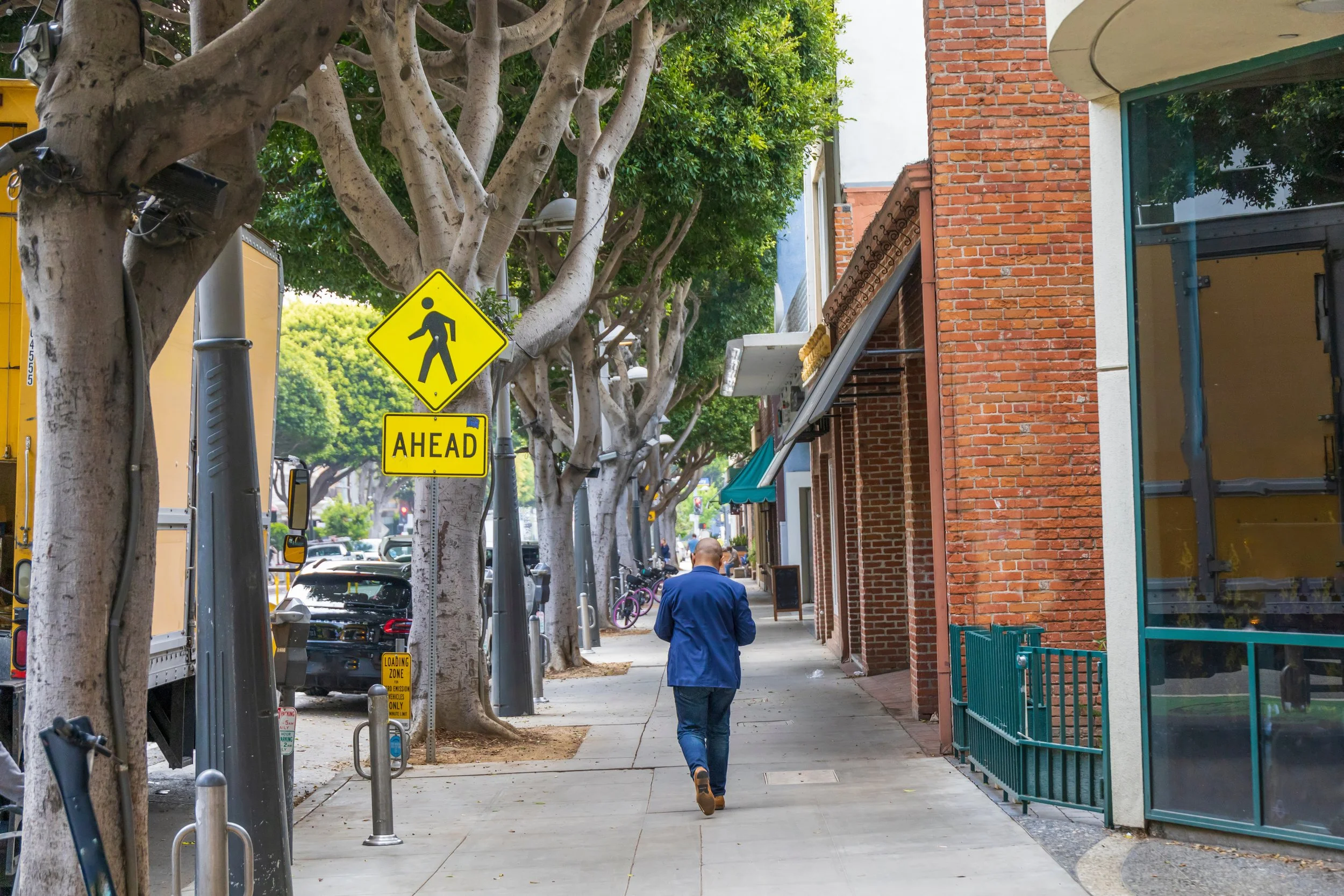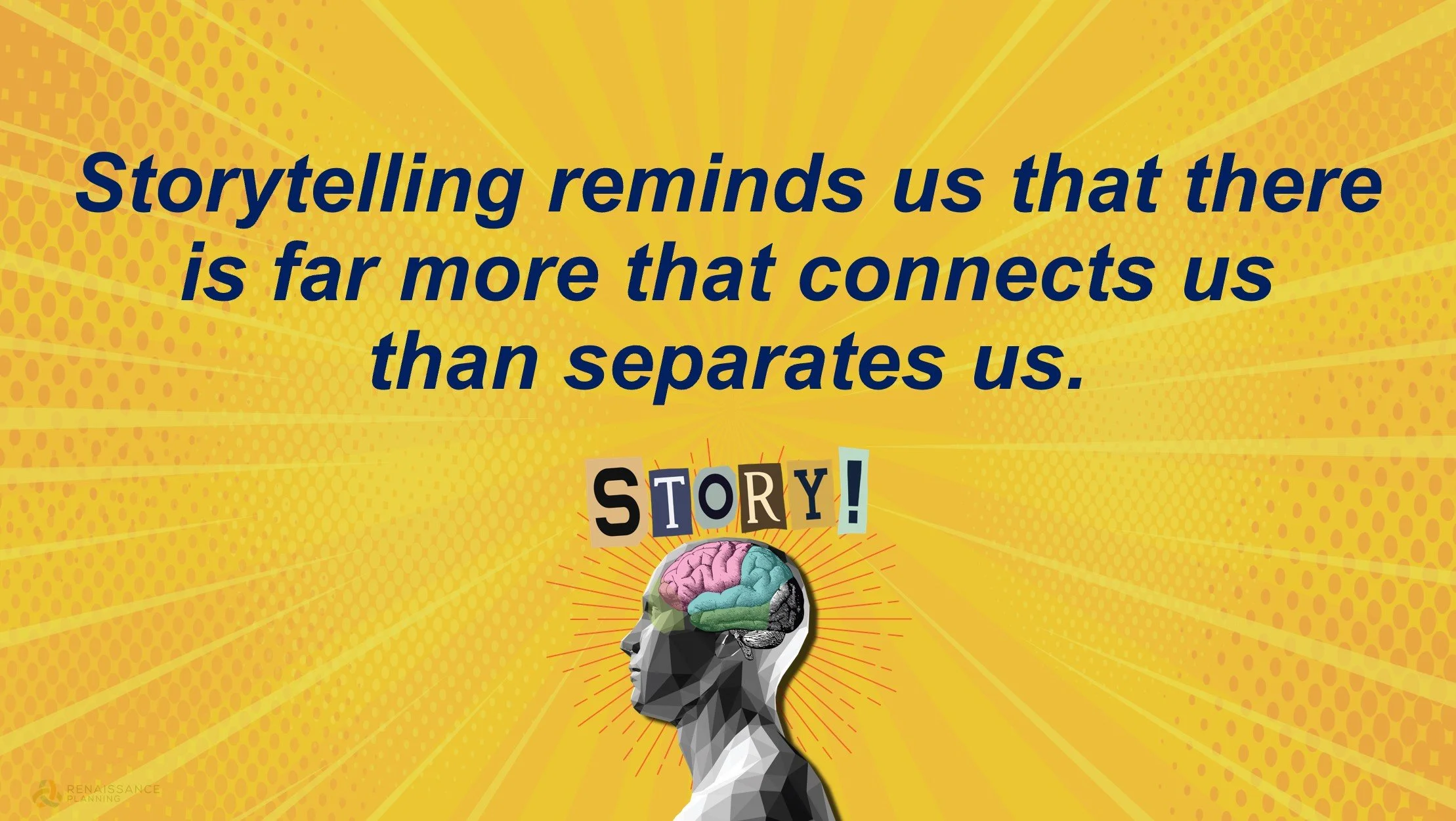This January, Renaissance Planning hosted graduate student Maya Claggett (MUEP 2025) as part of the University of Virginia’s week-long Externship Program.
Given that it's the 33rd anniversary of the Americans iwth Disability Act, it might be a good time to consider the state of our sidewalks.
Sidewalks are popular community connectors, but without small blocks, they won’t get used. Thirty years ago, nobody was talking about blocks and there are still few subdivision or zoning ordinances that regulate in support of small blocks. The table below however, (courtesy of David Green - architect and urbanist) shows an interesting analysis by the late Doug Allen at Georgia Tech. More regulation ironically gave rise to less consistency. The analysis also shows the growth in block size before and after the adoption of subdivision regulations and implementation of urban renewal. They expanded due to car-oriented subdivision regulations and capital investments.
Notably, subdivision literally means, "a tract of land surveyed and divided into lots for purposes of sale" according to Merriam-Webster. Merriam-Webster doesn't even provide a definition of block relative to the city. The Cambridge Dictionary, however, does define the city block as, “the distance along a street from where one road crosses it to the place where the next road crosses it, or one part of a street like this, especially in a town or city." Sadly, the nine experts in this article on why accessible sidewalks are the best infrastructure investment communities can make, do not even mention block size. Can any one of us recall a place where we’ve enjoyed walking that doesn’t have a network of small blocks?
An important companion to Doug Allen's analysis is the work of Norman Garrick and Wesley Marshall. Large blocks are more dangerous than the walkable, tight-knit, block networks of historic cities. See their 2010 study, here.
For more recent work by Marshall, check out his "Research Gallery" on his website here.
In short, promoting more investments in building and repairing sidewalks and multi-modal streets in general to be more inclusive and provide more modal choice is necessary but not sufficient to enable use to their full potential. Truly sustainable, equitable cities that work well for everyone are built on small blocks.
Renaissance is excited to extend a warm welcome to our newest Principal and Project Manager, Jennifer Stults, AICP, CTP, CPM, FCCM who will be based in our Orlando headquarters. Jennifer’s comprehensive understanding of transportation planning, public transit, and dedication to excellence will undoubtedly contribute to our ongoing efforts to enhance mobility, improve multimodal infrastructure, and help create cities that work.
With over 25 years of professional experience as a certified planner, Jennifer brings extensive transportation planning experience, public transit, project management, and leadership from both the public and private sectors working primarily in Florida. Most recently, Jennifer was the Planning and Environmental Management Administrator for Florida’s Turnpike Enterprise (FTE) with Florida's Department of Transportation (FDOT).
Her areas of specialization include transportation planning, public transit, planning and environmental management, Project Development & Environment (PD&E), Metropolitan Planning Organizations (MPOs), growth management, freight, and other modes. Jennifer’s diverse expertise, her depth of experience, and her knowledge of multimodal systems planning position her to make a significant impact on the future direction of Renaissance and the communities we serve.
Jennifer brings invaluable experience and transportation knowledge gained through her work with FDOT and collaboration with various public agencies, MPOs, and municipalities across Florida. Jennifer will help guide Renaissance’s strategy through leadership as a Principal, and she will oversee Renaissance’s multidisciplinary planners, urban designers, data analysists, cartographers, and strategic storytellers to execute integrated transportation planning projects as a Project Manager as well. Her projects will range from Federal and State policy development and technical assistance to multimodal corridor and sub-area studies.
Jennifer has a Master’s Degree in Urban and Regional Planning from Florida State University, and a Bachelor’s Degree in Environmental Studies from Rollins College. Her professional certifications include the American Institute of Certified Planners (AICP), AICP Certified Transportation Planner (CTP), Certified Public Manager (CPM), and Florida Certified Contract Manager (FCCM).
Please join us in congratulating and supporting Jennifer as she embarks on this exciting journey with Renaissance. Her wealth of experience, combined with her passion for creating efficient transportation systems, will undoubtedly help propel Renaissance forward in our mission to provide effective and sustainable solutions to create cities that work.
We believe in the power of storytelling and narrative. Do you?
To a skeptic, I might ask: “What is your legacy and who will tell your story?” This is often part of a series of related personal questions that I ask in many of the videos and storytelling approaches we lead at Renaissance. Digging deep to find the core “Why” within the communities we serve helps to make storytelling meaningful and helps reveal rich, hidden, or invisible narratives that can elevate shared visions and align community goals for real projects. These are some of the many reasons storytelling is so important to our work.
My purpose and work with Renaissance – especially in my role as our Storytelling Practice Lead – is all about seeing a place, listening to residents, gathering local stories, and uncovering important place-based and human-centered narratives to help serve planning, engagement, and design goals for the clients and communities that we serve. We recently had the opportunity to share more in-depth about our multimedia storytelling approach and methods for inclusive public engagement at the National American Planning Association conference in Philadelphia this April. Our APA NPC23 session, “Storytelling, not Yelling: Toward More Inclusive Community Engagement” highlights innovative video and storytelling practices that have successfully supported public engagement, stakeholder workshops, and client consensus-building with “Community Vision Stories” from urban and rural contexts.
Our storytelling practice has many layers. Authentic narratives can shape the way we see and form our communities, families, home, self, and how we fit into our “social imaginary” – our shared moral and social existence, coined by philosopher Charles Taylor. When supported by our multidisciplinary team, our thoughtful two-pronged approach – first, story-gathering and then storytelling – helps us better understand the communities we serve, which leads to better visions and actions for future change.
“Who Lives, Who Dies, Who Tells Your Story” is a deeply emotional refrain and finale song of the Pulitzer Prize winning Broadway musical, Hamilton, about the tragic yet influential life of one of the lesser-known Founding Fathers. Stay with me here. This song (even if you’ve never heard it, notice the story structure from the words alone) exemplifies my confidence that the stories we tell and share about ourselves, our community, our work, or our purpose have the power to harness emotions, drive decision-making, and fuel collective action.
Storytelling, within our modern planning practice and community engagement contexts, builds upon a rigorous foundation of the art and science of narratives that is nearly as old as human evolution itself. Many scientists and paleoanthropologists believe that narratives are the oldest and primary ways humans make sense of the world. As our brains evolved and languages developed (estimated around 100,000 years ago) so did storytelling. Aristotle, in his Poetics from 2,300 years ago, first articulated that a successful narrative arc starts with a mystery, builds tension with conflict, reaches an exciting climax or crisis, and then ends with a satisfying resolution. Many of Shakespeare’s stories have a similar narrative structure. The indefatigable and brilliant Taylor Swift, “one of America’s great storytellers,” has countless songs – including Anti-Hero with an infectious hook and vivid imagery – that harness the power of storytelling in classic yet innovative ways. (See our TikTok for more pop mixed with planning.) Story structures and narrative elements that grab our attention while engaging our brain and emotions with human-centered stories should be inspiration and evidence for planners seeking more meaningful strategies for community-based work.
Another relevant and applicable narrative arc – one that is easy to apply to place-based planning or engagement storytelling – is the “Man in a Hole” story structure. The author Kurt Vonnegut once said, “Nobody ever lost money telling the story of a Man in a Hole.” This structure begins with a comfort zone, then there is a trigger that leads to a crisis. This crisis or low point is where discovery, transformation, and a turning point leads to the recovery and finally a better place or resolution. This is similar to the aforementioned narrative arc. For many of our planning projects, videos, and storytelling products, I use this story structure to help frame and mold the information gathered into a coherent and engaging story.
Storytelling evokes a strong neurological and emotional response. A range of recent neuroscience has shown that this kind of story structure lights up our whole brain and produces a strong emotional response with a cascade of hormones and brain activity. For instance, research based on more than 50,000 brain observations by neuroscientist Paul J. Zak for his 2022 book Immersion (as well as many other articles including the Harvard Business Review) has shown that immersive stories have the power to persuade, shift our opinions or beliefs, build empathy and trust for others, and help us attune to details and other humans. Our brains will produce oxytocin, endorphins, cortisol, dopamine, and other neurotransmitters across brain hemispheres, throughout our body, limbic system, and vagus nerve due to the structure and narrative elements of an immersive story. When done well, and within the appropriate context of the communities we serve, authentic storytelling has a wide range of benefits for inclusive and equitable outcomes.
From Aristotle’s Poetics, Shakespeare, and Lin-Manuel Miranda’s groundbreaking Hamilton, to Taylor Swift and researchers like Paul J. Zak, the power, the art, and the science of storytelling has been well established. The importance of a well-told narrative arc and structure is vital to everything from music, film, Broadway, marketing, and advertising. Yet, why is storytelling not taught in university planning masters programs? Why do most planning, design, or architecture firms not invest nor hire for strong storytelling? Why do most public agencies, procurement departments, capital investment plans, RFPs, or project scope rarely outline storytelling approaches or deliverables?
Of course, storytelling is not a cure-all, and I cannot account for the reasons why storytelling and story production are not well supported by public agency procurement departments, project budgets, or university curriculum. I can only return to the question I might ask a sceptic about our legacy or collective purpose; to the Hamilton refrain of who lives, who dies, and who tells your story – and that storytelling reminds us that there is far more that connects us than separates us.
Many of our storytelling projects and videos can be viewed on our Renaissance YouTube channel here.
This insights post was written by Asa Eslocker. Prior to Renaissance, he worked at ABC News in New York where he was awarded a 2008 National News Emmy Award for “The Multi-Million Dollar Appeal.”
Renaissance hosted Meredith Beavers in January as part of the University of Virginia Externship Program. Meredith is a Masters of Urban and Environmental Planning student with a concentration in Design and was selected to join Renaissance for a two-week-long externship experience over her winter break.
Meredith has experience working at a regional planning commission in Southwest Virginia while earning a Bachelor’s in Smart & Sustainable Cities, Bachelor's in Political Science, and minors in Leadership & Social Change and Visual Arts from Virginia Tech.
Renaissance Planning Group stood out to Meredith, and various lines on the website made her eager to work with the team and contribute to creating “Cities that Work.”
We are multidisciplinary city planners…
While at Virginia Tech, a mentor told Meredith, “Planners wear many hats,” meaning the planning field requires those within it to be flexible and approach projects from various angles. Meredith says, “Describing the role of an Urban Planner has always been a challenging task because planners are extremely dynamic, and their responsibilities vary greatly.”
Meredith says she found the multidisciplinary approach “very evident” at Renaissance “through the various individual backgrounds and how the team works together.” While externing, Meredith described team meetings as “collaborative environments” and notes, “it is clear each person is a unique asset to the integrated planning process.” The assortment of planning and consulting projects at Renaissance has been exciting for Meredith as it allows planners to experience a range of projects and provide fresh perspectives.
We view cities as dynamic, interconnected, living organisms…
During her work with Renaissance, Meredith conducted preliminary research for a project in Avon Park, Florida. “It showed me how passionate Renaissance is about understanding the area and the community members.” She noted this is a priority across all projects, “planners genuinely put in the work to understand each project area and its spiderweb of interconnectedness, exemplifying their understanding of dynamic cities.”
Meredith was inspired by engaging in the process and learning about Renaissance's organizational structure and the methodologies employed to create “cities that work.” Following her two-week externship, Meredith has stayed on the team as a Planning Intern and has been recently helping with a transportation project in South Miami-Dade, Florida. We look forward to our continued work with Meredith and hope to see her flourish as a professional after her graduation from UVA this spring.
This week, the US government released a groundbreaking Blueprint for Transportation Decarbonization that highlights the vital role of urban design for compact, complete communities in reducing carbon emissions and addressing changing climate. The Blueprint outlines in-depth approaches for street design, zoning, transit-oriented development, and makes clear the importance of planning compact, connected communities. One of the more urgent first steps identified in the report is to, “Support land-use, street design, and development policies that make walking, biking, and rolling easier, safer, and more convenient.”
This is the first federal plan to make the explicit connection between urban design and climate change, and it outlines a national strategy for effectively involving states and cities to improve how communities are physically planned and designed in order to address and adapt to global climate change.
This blueprint lays out a strategic plan for practitioners of smart growth to “increase convenience and reduce emissions by making it possible for people to take fewer or shorter trips.” To execute this holistic and integrated approach to planning and design, it will require all the expertise we already have in the Renaissance wheelhouse. We look forward to exploring this exciting opportunity.













